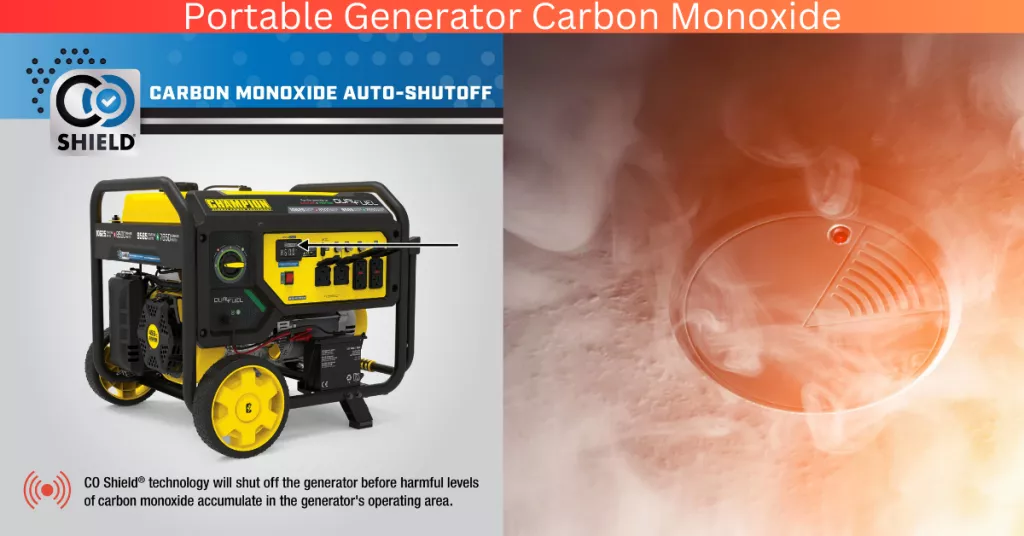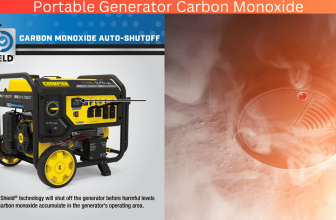As someone who has experienced a power outage, I know how frustrating it can be to go without electricity for an extended period of time. That’s why many people invest in portable generators to provide a temporary source of power during emergencies or outdoor events. However, what many people don’t realize is that portable generators can pose a serious danger if not used properly.
Carbon monoxide poisoning is a very real risk associated with portable generators, and in extreme cases, it can even be fatal. In this article, I will provide you with essential information on how to mitigate carbon monoxide risks when using portable generators. I will cover everything from understanding the dangers of carbon monoxide poisoning to proper placement, ventilation requirements, maintenance and inspection, safe operation, CO detectors, emergency response, legal requirements, and more.
By the end of this article, you will have a comprehensive understanding of how to safely and effectively use portable generators without putting yourself or others at risk. So let’s get started on the path to mastery of mitigating carbon monoxide risks from portable generators.
Key Takeaways
- Proper placement of a generator is crucial to prevent dangerous levels of carbon monoxide in your home.
- Education and awareness are crucial in mitigating carbon monoxide risks.
- Use a carbon monoxide detector inside the home or structure where the generator is being used.
- Always follow the manufacturer’s instructions and maintenance schedule for your generator.

Understanding the Dangers of Carbon Monoxide Poisoning
You need to understand the dangers of carbon monoxide poisoning before you even think about using a portable generator. Carbon monoxide is a colorless, odorless gas that can be deadly if inhaled in large quantities.
When a portable generator is running, it produces carbon monoxide, which can quickly build up in an enclosed space, such as your home or garage. Symptoms of carbon monoxide poisoning include headache, dizziness, nausea, and confusion. If left untreated, it can lead to loss of consciousness and even death.
It’s important to remember that carbon monoxide poisoning can happen to anyone, regardless of age or physical condition. That’s why it’s crucial to take the necessary precautions when using a portable generator. By understanding the risks associated with carbon monoxide poisoning, you can take the necessary steps to protect yourself and your loved ones.
With that in mind, let’s move on to the next section, which discusses the proper placement of portable generators.
Proper Placement of Portable Generators
Improper placement of a generator can lead to dangerous levels of carbon monoxide in your home, putting your family at risk. It’s important to place your portable generator outside and away from windows, doors, and vents. This will help ensure that any exhaust fumes are directed away from your living spaces.
Additionally, you shouldn’t place your generator in an enclosed space, such as a garage or shed. Even with the doors and windows open, the risk of carbon monoxide poisoning is still high. Instead, place your generator on a dry, level surface that’s at least 20 feet away from your home. This will help keep your family safe and prevent any harmful fumes from entering your living space.
As we move into discussing ventilation requirements, it’s important to keep in mind the proper placement of your generator to ensure that proper ventilation can be achieved.
Ventilation Requirements
One important factor to consider when using a generator is ensuring proper ventilation to prevent harmful fumes from accumulating in enclosed spaces. Carbon monoxide is a colorless and odorless gas that can be deadly if inhaled in high concentrations. To avoid this risk, it’s essential to follow these three ventilation requirements:
- Always use the generator outdoors, away from open windows, doors, or vents. The exhaust from the generator should be directed away from the living area to prevent fumes from entering the building.
- Use a carbon monoxide detector inside the home or structure where the generator is being used. This device will alert you if there are high levels of carbon monoxide in the air, giving you enough time to evacuate and seek medical assistance if necessary.
- Do not place the generator in an enclosed space, such as a garage or basement. Even if the space has windows or doors, it may not provide enough ventilation to prevent carbon monoxide buildup.
As important as ensuring proper ventilation is, it’s also critical to perform regular maintenance and inspection on your generator to prevent potential hazards.
Maintenance and Inspection
Ensuring the proper maintenance and regular inspection of your generator is essential for preventing potential hazards and ensuring its optimal performance. Neglecting maintenance and inspection can result in carbon monoxide buildup and other dangerous situations. Some key maintenance tasks include checking the oil level and changing it as recommended by the manufacturer, cleaning or replacing air filters, and inspecting the fuel system for leaks.
Regular inspection should also be part of your generator maintenance routine. It is important to inspect the generator for debris and damage, such as dents or cracks in the housing or loose connections. Additionally, inspect the exhaust system for leaks or damage, and check the spark plug and battery for proper operation. Proper maintenance and inspection can prevent costly repairs and ensure the safe and efficient operation of your generator.
To safely operate your generator, there are specific steps you should take to minimize the risks of carbon monoxide exposure.
Safe Generator Operation
To safely operate a generator, it’s important to follow specific guidelines and take necessary precautions. First and foremost, never operate a generator indoors or in an enclosed space. This includes garages, basements, and even partially enclosed areas. Generators should always be placed outdoors, away from windows, doors, and vents, to prevent carbon monoxide from entering the home.
Additionally, make sure to use only properly rated extension cords and connect appliances directly to the generator. Overloading the generator can cause it to malfunction and emit dangerous levels of carbon monoxide. Finally, always turn off the generator and let it cool before refueling. Spilling fuel on a hot generator can ignite and cause a fire.
By following these guidelines, you can safely operate a generator and minimize the risk of carbon monoxide poisoning.
As important as it is to safely operate your generator, education and awareness are also crucial in mitigating carbon monoxide risks. It’s important to understand the symptoms of carbon monoxide poisoning and have a carbon monoxide detector installed in your home.
In the next section, we’ll discuss the importance of education and awareness in more detail.
Education and Awareness
Make sure you educate yourself and your family on the dangers of carbon monoxide and the importance of having a working detector in your home. Carbon monoxide is an odorless, colorless gas that can be deadly in high concentrations. It’s produced when fuel is burned, such as in generators, and can quickly accumulate in enclosed spaces.
To avoid the risk of carbon monoxide poisoning, consider the following:
- Always use generators outside and keep them at least 20 feet away from your home.
- Install carbon monoxide detectors on every level of your home and near sleeping areas.
- Test your detectors regularly and replace the batteries at least once a year.
By taking these simple steps, you can help protect yourself and your family from the dangers of carbon monoxide.
In the next section, we’ll discuss the importance of having a working CO detector in your home.
CO Detectors
Having a functioning CO detector in your home is crucial for protecting your family from the silent threat of carbon monoxide. Carbon monoxide is an odorless, colorless gas that can be emitted from portable generators. The danger lies in the fact that it is impossible to detect without the proper equipment. A CO detector can save lives by alerting you to the presence of the gas before it becomes lethal.
To better understand the importance of having a CO detector, let’s take a look at the following table:
| Level of CO | Symptoms | Health Effects |
|---|---|---|
| 9 ppm | None | Safe level |
| 35 ppm | Headache and dizziness | May cause flu-like symptoms |
| 200 ppm | Headache, dizziness, and nausea | May cause death within 2-3 hours |
| 400 ppm | Headache, dizziness, and nausea within 1-2 hours | May cause death within 1-2 hours |
| 800 ppm | Headache, dizziness, and nausea within 45 minutes | May cause death within 45 minutes |
As you can see, even low levels of carbon monoxide can cause symptoms and health effects. It is essential to have a CO detector installed in your home and to test it regularly to ensure it is functioning correctly. In the event that the detector goes off, it is crucial to take immediate action and evacuate the area.
Transitioning to the topic of emergency response, it is essential to have a plan in place in case of a carbon monoxide leak.
Emergency Response
When you hear the piercing sound of the CO detector, your heart races as you quickly gather your family and rush out of the house to safety. Emergency response is critical in mitigating the risks of carbon monoxide poisoning. Here are five things you should keep in mind:
- Don’t waste time trying to figure out the source of the CO. Every second counts, so get out of the house as soon as possible.
- Call the emergency services immediately. They have the necessary equipment to detect and identify the source of the CO and can provide medical assistance if needed.
- Don’t go back into the house until the emergency services have given you the all-clear. Even if the CO levels have dropped, there may still be pockets of gas that can pose a risk.
- Seek medical attention if you experience any symptoms of CO poisoning, such as headache, dizziness, nausea, and confusion.
- Once you’re safe, take the time to review your emergency plan and ensure that everyone in your family knows what to do in case of a CO emergency.
It’s important to be prepared for emergencies, but it’s also important to understand the legal requirements for using portable generators.
Legal Requirements
As we discussed earlier, emergency response is crucial in mitigating carbon monoxide risks from portable generators. However, it is also important to consider the legal requirements that govern the use of these generators. As a responsible user, it is my duty to ensure that I comply with all relevant laws and regulations to avoid any legal consequences.
To help you understand the legal requirements, I have prepared a table that outlines the key regulations that govern the use of portable generators. These regulations cover a range of aspects, from emissions standards to safety requirements. By following these regulations, we can not only avoid legal issues but also ensure that we operate our generators safely and responsibly.
Transitioning to the next section, it is important to remember that compliance with legal requirements is just one aspect of using portable generators safely. In the next section, I will provide some recommendations on how we can further reduce the risks associated with carbon monoxide and improve our overall safety when using portable generators.
Conclusion and Recommendations
In conclusion, there are several best practices for using portable generators that can help mitigate the risks of carbon monoxide poisoning. These include proper placement of the generator, regular maintenance, and using carbon monoxide detectors.
For those who want to learn more, there are many resources available, including government websites and safety organizations. It’s important for all of us to take responsibility for safe generator use and to educate others on the dangers of carbon monoxide poisoning.
Ultimately, let’s make sure we’re doing everything we can to keep ourselves and our loved ones safe. Let’s remember to use generators in a well-ventilated area and to never use them indoors or in an enclosed space. With these precautions in mind, we can enjoy the convenience of portable generators while keeping our health and safety a top priority.
Summary of Best Practices
The most important thing to remember is to never use a portable generator indoors, as this can lead to deadly levels of carbon monoxide. Always place your generator outside and away from open doors or windows, and never run it in an enclosed space like a garage or basement.
If it’s raining or snowing, make sure your generator is protected from the elements with a cover or canopy, but still placed outside.
Another best practice is to install carbon monoxide detectors in your home, especially near sleeping areas. These can alert you if dangerous levels of carbon monoxide are present, allowing you to take action before it’s too late.
And finally, always follow the manufacturer’s instructions and maintenance schedule for your generator to ensure it’s running safely and efficiently.
By following these best practices, you can mitigate the risks of carbon monoxide poisoning and safely use your portable generator when you need it.
For more information on generator safety, consult the resources listed in the next section.
Resources for Further Information
Don’t forget to check out the additional resources available for more information on safely using your generator. Learning about the best practices is just the first step in mitigating the risks of carbon monoxide poisoning from portable generators. Here are some great resources that can provide you with more information on safe generator use:
| Resource | Description | Link |
|---|---|---|
| Consumer Product Safety Commission | Provides safety tips and guidelines for using portable generators | https://www.cpsc.gov/safety-education/safety-guides/home/generators |
| Centers for Disease Control and Prevention | Offers information on the health effects of carbon monoxide and how to prevent exposure | https://www.cdc.gov/co/generators.htm |
| Portable Generator Manufacturers’ Association | Offers tips and information on safe generator use, maintenance, and storage | https://www.pgmaonline.com/safety-and-education |
| Occupational Safety and Health Administration | Provides guidelines for employers and employees on safe generator use in the workplace | https://www.osha.gov/dts/otpca/natstand/portable_generators.html |
| National Fire Protection Association | Offers safety tips for preventing carbon monoxide poisoning and electrical hazards from generators | https://www.nfpa.org/Public-Education/Staying-safe/Safety-equipment/Generators |
These resources are a great way to continue your education on safe generator use and reduce the risks of carbon monoxide poisoning. Remember, the more you know, the safer you’ll be!
Transitioning to the next section, it’s important to take action to ensure safe generator use.
Call to Action for Safe Generator Use
Let’s take action to ensure we use our generators safely and prevent any accidents from happening. The first step is to read the manufacturer’s instructions and follow them strictly. Make sure you know how to operate the generator safely, including how to start it, how to refuel it, and how to turn it off properly.
Never use a generator indoors or in an enclosed space, as it can lead to carbon monoxide poisoning. Instead, place the generator outside, away from any windows or doors, and use a weatherproof cover to protect it from the elements.
Another important step is to install carbon monoxide detectors in your home. These detectors will alert you if there is a dangerous level of carbon monoxide in the air. You should also never use a generator to power appliances that produce heat, such as ovens, stoves, or heaters. Instead, use the generator to power lights, fans, and other small appliances.
By taking these simple steps, you can ensure that you use your generator safely and avoid any accidents or injuries. Let’s work together to keep ourselves and our families safe from the dangers of carbon monoxide.
Frequently Asked Questions
Are all portable generators prone to producing carbon monoxide, or are there some models that are safer than others?
Yes, some portable generators are safer than others when it comes to carbon monoxide production. It’s important to do research and choose a model with built-in safety features, such as automatic shut-off when CO levels are high.
How long does it typically take for carbon monoxide to become a serious health risk when using a portable generator?
It only takes a few minutes for carbon monoxide to become a serious health risk when using a portable generator. That’s why it’s important to always use them outdoors in a well-ventilated area.
Can a generator be safely used indoors if it is placed near an open window or door?
No, a generator should never be used indoors, even near an open window or door. Carbon monoxide can still build up and pose a serious health risk. Always use generators outdoors and away from living areas.
What are some of the most common signs and symptoms of carbon monoxide poisoning to look out for?
Some common signs of carbon monoxide poisoning include headache, dizziness, weakness, nausea, and confusion. If you suspect exposure, move to fresh air immediately and seek medical attention. Don’t ignore these symptoms – they could save your life.
What should I do if I suspect that someone is experiencing carbon monoxide poisoning?
If I suspect someone has carbon monoxide poisoning, I need to act fast. I’ll move them to fresh air, call 911, and stay with them until help arrives. Remember, early intervention can save lives.
Conclusion
In conclusion, ensuring the safe use of portable generators is crucial in mitigating the risks of carbon monoxide poisoning. Understanding the dangers of CO poisoning, proper placement of generators, ventilation requirements, maintenance and inspection, and safe operation are all essential in preventing this deadly gas from harming individuals.
It’s also important to have CO detectors installed in homes and businesses in case of any leaks. Additionally, it’s important to be aware of the legal requirements surrounding the use of portable generators, such as obtaining necessary permits and following local regulations.
By following these guidelines and taking necessary precautions, we can minimize the risks associated with portable generators and ensure the safety of ourselves and those around us.






